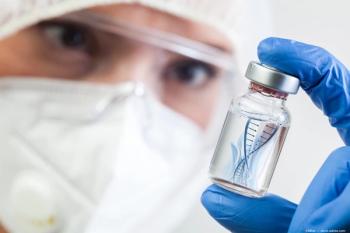
Why intensive diagnostic evaluation, management of peripheral ulcerative keratitis is a must
Peripheral ulcerative keratitis (PUK) is a complex, sight-threatening inflammatory disease that requires multimodal treatment. Corticosteroids are considered the mainstay, but a variety of other interventions are used to prevent progression and promote healing. Identification of any underlying cause is also important for directing therapeutic intervention, said Radhika Tandon, MD.
New Delhi, India-Peripheral ulcerative
“All PUK is triggered by an immunological reaction that leads to infiltration of inflammatory cells with subsequent release of keratolytic enzymes and inflammatory cytokines,” said Dr. Tandon, professor of
Image of a case demonstrating healing with vascularization and severe sight threatening corneal scarring as a consequence of Peripheral Ulcerative Image of a case demonstrating healing with vascularization and Keratitis (Photos courtesy of Radhika Tandon, MD)
“Therefore, medical therapy involves treatment with anti-inflammatory/immunosuppressive medications and other agents to mitigate the effects of the immunologic response,” she continued. “However, determination of the etiology will enable better management in a more systematic fashion. So, when facing a patient with PUK, clinicians must take a careful history, perform a thorough clinical examination, and conduct the relevant diagnostic investigations.”
PUK is most commonly associated with an autoimmune disease, but it may also have an infectious etiology, arise from a hypersensitivity reaction, or be idiopathic (i.e., Mooren ulcer).
Dr. Tandon noted that in taking the history, clinicians should query patients specifically about systemic disorders as they may fail to spontaneously report past or even active disease. In addition, she reminded clinicians not to overlook the possibility of atypical presentations of etiologies known to be associated with PUK.
In addition to a corticosteroid, topical medical therapy for PUK includes the use of cycloplegics and agents that promote healing, including topical lubricants, carmellose, and autologous serum. Furthermore, topical broad spectrum antibiotic may be prescribed as prophylaxis against secondary bacterial infection.
Example of a case of peripheral ulcerative keratitis with active inflammation and corneal perforation. Investigations to rule out local and/or systemic infection and autoimmune or other inflammatory disorders should be undertaken. Surgical treatment with a patch graft will be required to save the integrity of the eye and provide a chance to restore vision.
Adjuvant therapy using systemic agents to prevent collagen degradation and promote collagen synthesis, such as medroxyprogresterone, N-acetyl cysteine, and tetracycline, may also be considered.
Dr. Tandon noted that topical cyclosporine A can be a useful adjunct to standard medical therapy in recalcitrant cases of PUK, but may also have a role in patients who are responding medically. A paper published by Dr. Tandon and colleagues several years ago described the safe and effective use of topical cyclosporine A 2% administered 4 times daily for 1 to 3 months [Cornea. 2008;27:859-861].
Dr. Tandon said there are four indications for using systemic anti-inflammatory/immunosuppressive treatment of PUK:
1) Lethal systemic vasculitis syndromes
2) Necrotizing scleritis and vasculitis on histopathology
3) Bilateral and/or progressive Mooren’s ulcer
4) Progressive ulceration resistant to conventional medical and surgical treatment
“Traditionally, methotrexate has been the systemic immunosuppressive medication that is added to corticosteroid treatment,” Dr. Tandon said. “More recently, however, mycophenolate mofetil has been suggested to be a better option because it is less toxic and more effective.”
The approach to surgical intervention depends on the ulcer size and location. A small ulcer can be managed by applying fibrin glue covered with a bandage contact lens or amniotic membrane. Conjunctival resection and amniotic membrane inlay and onlay grafts should be considered when the ulceration and thinning are progressing, and a patch graft is needed for a larger ulcer or if there is impending or actual perforation, she said.
“Some patients with PUK may be very sick because of their underlying systemic disease and cannot be taken to the operating room for surgery,” Dr. Tandon said. “In that situation, fibrin glue and an amniotic membrane graft can provide a barrier and stave off further thinning until the patient is able to undergo definitive surgery.”
The choice between a lamellar or full thickness graft depends on the nature of the defect, and patients may eventually need to undergo lamellar or full-thickness keratoplasty or even later keratoprosthesis surgery for optical and visual rehabilitation.
Newsletter
Don’t miss out—get Ophthalmology Times updates on the latest clinical advancements and expert interviews, straight to your inbox.



















































.png)


